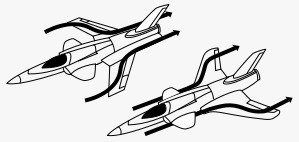Forward Sweeping is the concept of having the wings bent in the forward direction towards the fuselage (as seen in the picture of the X-29). Forward swept wings were first developed in the 1980s as an experiment to overcome many of the disadvantages of the rear sweep but little did we know what complications it would bring with it. To understand and evaluate the forward sweep we need to first understand why wings are swept back.

A wing typically works on bernoulli's principle where the air above the aerofoil has higher speed and lower pressure as compared to the air below it .This causes a net upward force on the wing known as lift. Consider an aircraft travelling at a mach number lower than one the air above the aerofoil can cross the speed of sound due to the curvature of the aerofoil and this can result in flow separation and generation of shock waves. This will result in the generation of immense drag and can also cause the aircraft to pitch downwards due to the increase in lift generation from the wings behind. As the wing has a rear sweep angle the chordwise (perpendicular to the wing span) component of the velocity does not cross mach one and flow separation along with shock wave is delayed.
One of the problems with rear sweep is the roll control by ailerons during high speed flight, as the air flows from the root to the wing tips stalling begins from the tips till the root and ailerons are located near the wing wing tips and if that part of the wing stalls then we can lose control of the aircraft at very nascent stages of velocity.They also generate a lot of drag due to generation of vortices on the wing tips where the low pressure and high pressure air meet. These types of problems lead to the development of forward sweep.


Both of these problems are solved by forward swept wings. As the air flow is now from the tips to the root we have better control of the aircraft because stalling begins at the roots where there are minimum control surfaces. Vortices are eliminated and also the center of pressure shifts behind the COG and hence we need small wings in the front to balance out the moment. Because of this shift the aircraft brings about lot of unstable characteristics, the aircraft is impossible to be in practice without a computer because it has to be adjusted for stable flight upto 40 times a second which is not possible manually, the testing by NASA on the X-29 had 3 computers on board incase one would fail. Flying in extreme weather will be a huge problem for this type of aircraft , these are the major reasons why this innovation was not taken into practical applications. The wing loads were also tremendously high,due to which special materials were needed during manufacturing of the wing. Although forward sweep did solve a lot of problems and increase efficiency but they were not incorporated into modern fighter jets because the advantages simply did not outweigh the cons. Also this design is useless for stealth purpose,so the rear sweep delta wing dominated.